Preparation of Double-Layer Crossed Silver Nanowire Film and Its Application to OLED
Abstract
:1. Introduction
2. Experimental and Results
2.1. Hydrophilic Treatment of the PET Substrate
2.2. Preparation of Ordered Silver Nanowire Film
2.3. Preparation of Transparent Composite Electrode Based on AgNWs
2.4. Fabrication of OLED Device Based on AgNW Composite Electrode
3. Summary
4. Equipment Description in the Paper
Author Contributions
Funding
Institutional Review Board Statement
Informed Consent Statement
Data Availability Statement
Conflicts of Interest
References
- Wang, Y.; Chen, X.; Zhong, Y.; Loh, K.P. Large area, continuous, few-layered graphene as anodes in organic photovoltaic devices. Appl. Phys. Lett. 2009, 95, 063302. [Google Scholar] [CrossRef]
- Kim, B.-J.; Lee, C.; Jung, Y.; Baik, K.H.; Mastro, M.A.; Hite, J.K.; Kim, J. Large-area transparent conductive few-layer graphene electrode in GaN-based ultra-violet light-emitting diodes. Appl. Phys. Lett. 2011, 99, 143101. [Google Scholar] [CrossRef]
- Pang, S.; Hernandez, Y.; Feng, X.; Mullen, K. Graphene as transparent electrode material for organic electronics. Adv. Mater. 2011, 23, 2779–2795. [Google Scholar] [CrossRef] [PubMed]
- Sa, K.; Mahanandia, P. Conducting reduced graphene oxide film as transparent electrode. Thin Solid Films 2019, 692, 137594. [Google Scholar] [CrossRef]
- Lee, B.J.; Yu, H.Y.; Jeong, G.H. Controlled Synthesis of Monolayer Graphene Toward Transparent Flexible Conductive Film Application. Nanoscale Res. Lett. 2010, 5, 1768–1773. [Google Scholar] [CrossRef] [PubMed] [Green Version]
- Chang, Y.-M.; Wang, L.; Su, W.-F. Polymer solar cells with poly(3,4-ethylenedioxythiophene) as transparent anode. Org. Electron. 2008, 9, 968–973. [Google Scholar] [CrossRef]
- Na, S.-I.; Kim, S.-S.; Jo, J.; Kim, D.-Y. Efficient and Flexible ITO-Free Organic Solar Cells Using Highly Conductive Polymer Anodes. Adv. Mater. 2008, 20, 4061–4067. [Google Scholar] [CrossRef]
- Zhou, L.; Yu, M.; Chen, X.; Nie, S.; Lai, W.; Su, W.; Cui, Z.; Huang, W. Screen-Printed Poly(3,4-Ethylenedioxythiophene): Poly(Styrenesulfonate) Grids as ITO-Free Anodes for Flexible Organic Light-Emitting Diodes. Adv. Funct. Mater. 2018, 28, 1705955. [Google Scholar] [CrossRef]
- Jiang, S.; Hou, P.-X.; Liu, C.; Cheng, H. High-performance single-wall carbon nanotube transparent conductive films. J. Mater. Sci. Technol. 2019, 35, 2447–2462. [Google Scholar] [CrossRef]
- Alshammari, A.S.; Sam, F.L.M.; Rozanski, L.J.; Mills, C.A.; Beliatis, M.J.; Jayawardena, K.D.G.I.; Underwood, J.M.; Silva, S. Controlled growth and spray deposition of silver nanowires for ITO-free, flexible, and high brightness OLEDs. Phys. Status Solidi A-Appl. Mater. Sci. 2017, 214, 1600561. [Google Scholar] [CrossRef]
- Lian, L.; Wang, H.; Dong, D.; He, G. Highly robust and ultrasmooth copper nanowire electrode by one-step coating for organic light-emitting diodes. J. Mater. Chem. C 2018, 6, 9158–9165. [Google Scholar] [CrossRef]
- Tseng, J.-Y.; Lee, L.; Huang, Y.-C.; Chang, J.-H.; Su, T.-Y. Pressure Welding of Silver Nanowires Networks at Room Temperature as Transparent Electrodes for Efficient Organic Light-Emitting Diodes. Small 2018, 14, 1800541. [Google Scholar] [CrossRef]
- Wang, Y.; Liu, P.; Wang, H.; Zeng, B.; Wang, J. Flexible organic light-emitting devices with copper nanowire composite transparent conductive electrode. J. Mater. Sci. 2018, 54, 2343–2350. [Google Scholar] [CrossRef]
- Park, K.; Woo, K.; Kim, J.; Lee, D.; Ahn, Y.; Song, D.; Kim, H.; Oh, D.; Kwon, S.; Lee, Y. High-Resolution and Large-Area Patterning of Highly Conductive Silver Nanowire Electrodes by Reverse Offset Printing and Intense Pulsed Light Irradiation. ACS Appl. Mater. Interfaces 2019, 11, 14882–14891. [Google Scholar] [CrossRef]
- Hecht, D.S.; Hu, L.; Irvin, G. Emerging Transparent Electrodes Based on Thin Films of Carbon Nanotubes, Graphene, and Metallic Nanostructures. Adv. Mater. 2011, 23, 1482–1513. [Google Scholar] [CrossRef]
- Layani, M.; Kamyshny, A.; Magdassi, S. Transparent conductors composed of nanomaterials. Nanoscale 2014, 6, 5581–5591. [Google Scholar] [CrossRef]
- Lee, J.-Y.; Connor, S.T.; Cui, Y.; Peumans, P. Solution-processed metal nanowire mesh transparent electrodes. Nano Lett. 2008, 8, 689–692. [Google Scholar] [CrossRef]
- Lee, J.-Y.; Connor, S.T.; Cui, Y.; Peumans, P. Semitransparent Organic Photovoltaic Cells with Laminated Top Electrode. Nano Lett. 2010, 10, 1276–1279. [Google Scholar] [CrossRef]
- De, S.; Higgins, T.M.; Lyons, P.E.; Doherty, E.M.; Nirmalraj, P.N.; Blau, W.J.; Boland, J.J.; Coleman, J.N. Silver Nanowire Networks as Flexible, Transparent, Conducting Films: Extremely High DC to Optical Conductivity Ratios. Acs Nano 2009, 3, 1767–1774. [Google Scholar] [CrossRef]
- Hu, L.; Kim, H.S.; Lee, J.-Y.; Peumans, P.; Cui, Y. Scalable Coating and Properties of Transparent, Flexible, Silver Nanowire Electrodes. ACS Nano 2010, 4, 2955–2963. [Google Scholar] [CrossRef]
- Guo, X.; Guo, C.W.; Wang, C.; Li, C.; Sun, X. AlGaInP LED with low-speed spin-coating silver nanowires as transparent conductive layer. Nanoscale Res. Lett. 2014, 9, 670. [Google Scholar] [CrossRef] [Green Version]
- Lagrange, M.; Langley, D.P.; Giusti, G.; Jimenez, C.; Brechet, Y.; Bellet, D. Optimization of silver nanowire-based transparent electrodes: Effects of density, size and thermal annealing. Nanoscale 2015, 7, 17410–17423. [Google Scholar] [CrossRef]
- Duan, X.F.; Huang, Y.; Cui, Y.; Wang, J.; Lieber, C. Indium phosphide nanowires as building blocks for nanoscale electronic and optoelectronic devices. Nature 2001, 409, 66–69. [Google Scholar] [CrossRef]
- Myung, S.; Lee, M.; Kim, G.T.; Ha, J.S.; Hong, S. Large-Scale “Surface-Programmed Assembly” of Pristine Vanadium Oxide Nanowire-Based Devices. Adv. Mater. 2005, 17, 2361–2364. [Google Scholar] [CrossRef]
- Heo, K.; Cho, E.; Yang, J.-E.; Kim, M.-H.; Lee, M.; Lee, B.-Y.; Kwon, S.-G.; Lee, M.-S.; Jo, M.-H.; Choi, H.-J. Large-Scale Assembly of Silicon Nanowire Network-Based Devices Using Conventional Microfabrication Facilities. Nano Lett. 2008, 8, 4523–4527. [Google Scholar] [CrossRef]
- Wang, M.C.P.; Gates, B.D. Directed assembly of nanowires. Mater. Today 2009, 12, 34–43. [Google Scholar] [CrossRef]
- Hassan, M.; Zhan, H.-J.; Wang, J.-L.; Liu, J.; Chen, J. Self-Assembly Anisotropic Magnetic Nanowire Films Induced by External Magnetic Field. ChemistryOpen 2020, 9, 588–592. [Google Scholar] [CrossRef]
- Duan, X.F.; Niu, C.M.; Sahi, V.; Chen, J.; Parce, J.; Empedocles, S.; Goldman, J. High-performance thin-film transistors using semiconductor nanowires and nanoribbons. Nature 2003, 425, 274–278. [Google Scholar] [CrossRef]
- Huang, Y.; Duan, X.F.; Wei, Q.Q.; Lieber, C.-M. Directed assembly of one-dimensional nanostructures into functional networks. Science 2001, 291, 630–633. [Google Scholar] [CrossRef] [Green Version]
- Yu, G.; Cao, A.; Lieber, C.M. Large-area blown bubble films of aligned nanowires and carbon nanotubes. Nat. Nanotechnol. 2007, 2, 372–377. [Google Scholar] [CrossRef]
- Qi, X.; Lu, Z.; You, E.M.; He, Y.; Zhang, Q.; Yi, H.; Li, D.; Ding, S.; Jiang, Y.; Xiong, X. Nanocombing Effect Leads to Nanowire-Based, in-Plane, Uniaxial Thin Films. ACS Nano 2018, 12, 12701–12712. [Google Scholar] [CrossRef] [PubMed]
- Noy, A.; Frisbie, C.D.; Rozsnyai, L.F.; Wrighton, M.S.; Lieber, C. Chemical Force Microscopy—Exploiting Chemically-Modified Tips to Quantify Adhesion, Friction, and Functional-Group Distributions in Molecular Assemblies. J. Am. Chem. Soc. 1995, 117, 7943–7951. [Google Scholar] [CrossRef]
- Cheng, S.; Xia, X.; Liu, H.; Chen, Y. Core-shell structured MoS2 @S spherical cathode with improved electrochemical performance for lithium-sulfur batteries. J. Mater. Sci. Technol. 2018, 34, 1912–1918. [Google Scholar] [CrossRef]
- Chen, Y.M.; Yu, X.Y.; Li, Z.; Paik, U.; Lou, X.W. Hierarchical MoS2 tubular structures internally wired by carbon nanotubes as a highly stable anode material for lithium-ion batteries. Sci. Adv. 2016, 2, e1600021. [Google Scholar] [CrossRef] [Green Version]
- Hao, X.; Jin, Z.; Yang, H.; Lu, G.; Bi, Y. Peculiar synergetic effect of MoS2 quantum dots and graphene on Metal-Organic Frameworks for photocatalytic hydrogen evolution. Appl. Catal. B-Environ. 2017, 210, 45–56. [Google Scholar] [CrossRef]
- Yang, Y.; Zhang, K.; Ling, H.; Li, X.; Chan, H.; Yang, L.; Gao, Q. MoS2-Ni3S2 Heteronanorods as Efficient and Stable Bifunctional Electrocatalysts for Overall Water Splitting. Acs Catal. 2017, 7, 2357–2366. [Google Scholar] [CrossRef]
- Peng, K.; Fu, L.; Yang, H.; Ouyang, J.; Tang, A. Hierarchical MoS2 intercalated clay hybrid nanosheets with enhanced catalytic activity. Nano Res. 2017, 10, 570–583. [Google Scholar] [CrossRef]
- Splendiani, A.; Sun, L.; Zhang, Y.; Li, T.; Kim, J. Emerging Photoluminescence in Monolayer MoS2. Nano Lett. 2010, 10, 1271–1275. [Google Scholar] [CrossRef]
- Lee, Y.-H.; Zhang, X.-Q.; Zhang, W.; Chang, M.; Lin, C.; Chang, K.; Yu, Y.; Wang, J.; Chang, C.; Li, L.; et al. Synthesis of Large-Area MoS2 Atomic Layers with Chemical Vapor Deposition. Adv. Mater. 2012, 24, 2320–2325. [Google Scholar] [CrossRef] [Green Version]
- Shi, Y.; Zhou, W.; Lu, A.-Y.; Fang, W.; Lee, Y.; Hsu, A.-L.; Kim, S.-M.; Kim, K.-K.; Yang, H.-Y.; Li, L.-J.; et al. van der Waals Epitaxy of MoS2 Layers Using Graphene As Growth Templates. Nano Lett. 2012, 12, 2784–2791. [Google Scholar] [CrossRef]
- Nicolosi, V.; Chhowalla, M.; Kanatzidis, M.G.; Strano, M.S.; Coleman, J.N. Liquid Exfoliation of Layered Materials. Science 2013, 340, 1420. [Google Scholar] [CrossRef] [Green Version]
- Gong, C.; Xiao, J.; Zhu, L.; Wang, Z.; Ma, S. Effect of Deposition Pressure on the Microstructure and Optical Band Gap of Molybdenum Disulfide Films Prepared by Magnetron Sputtering. Coatings 2019, 9, 570. [Google Scholar] [CrossRef] [Green Version]
- Zhou, P.; Li, W.; Jin, X. Electrochemical Hydrogen Permeation Properties of MoS2 and Ni80Cr20 Films Prepared by Magnetron Sputtering on Pure Iron. J. Electrochem. Soc. 2018, 165, E256–E261. [Google Scholar] [CrossRef]

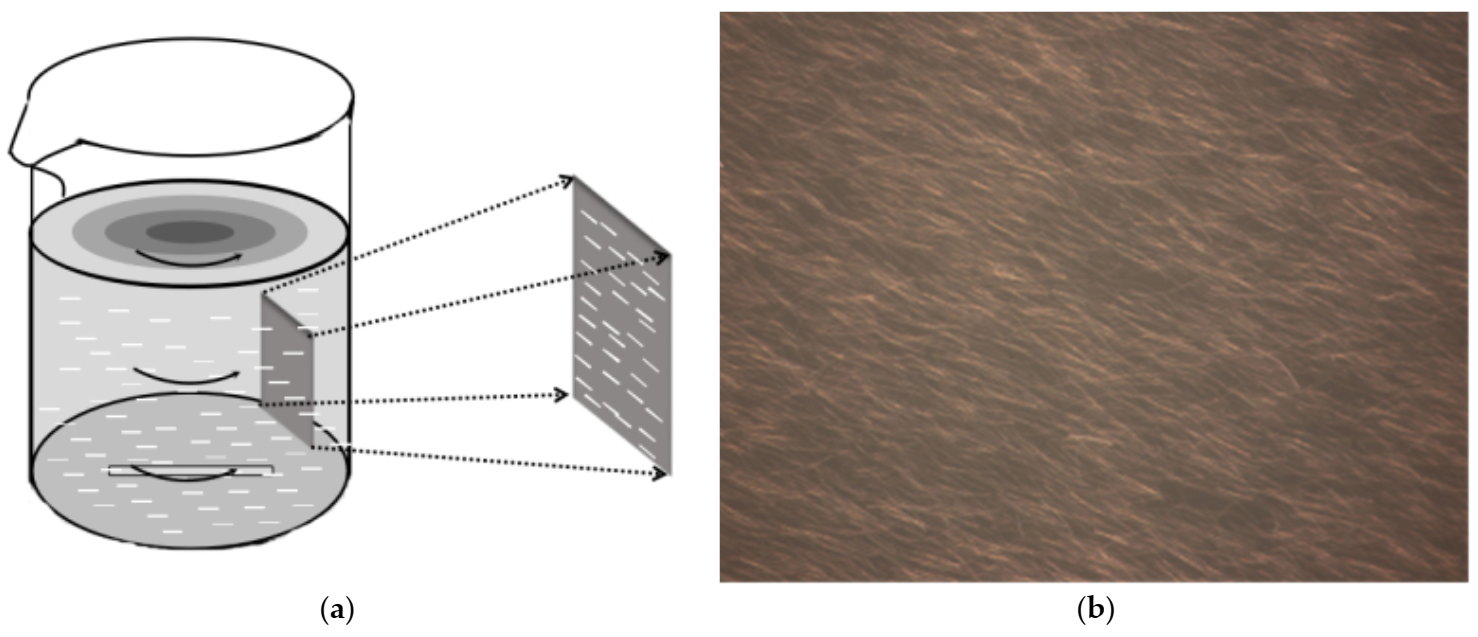



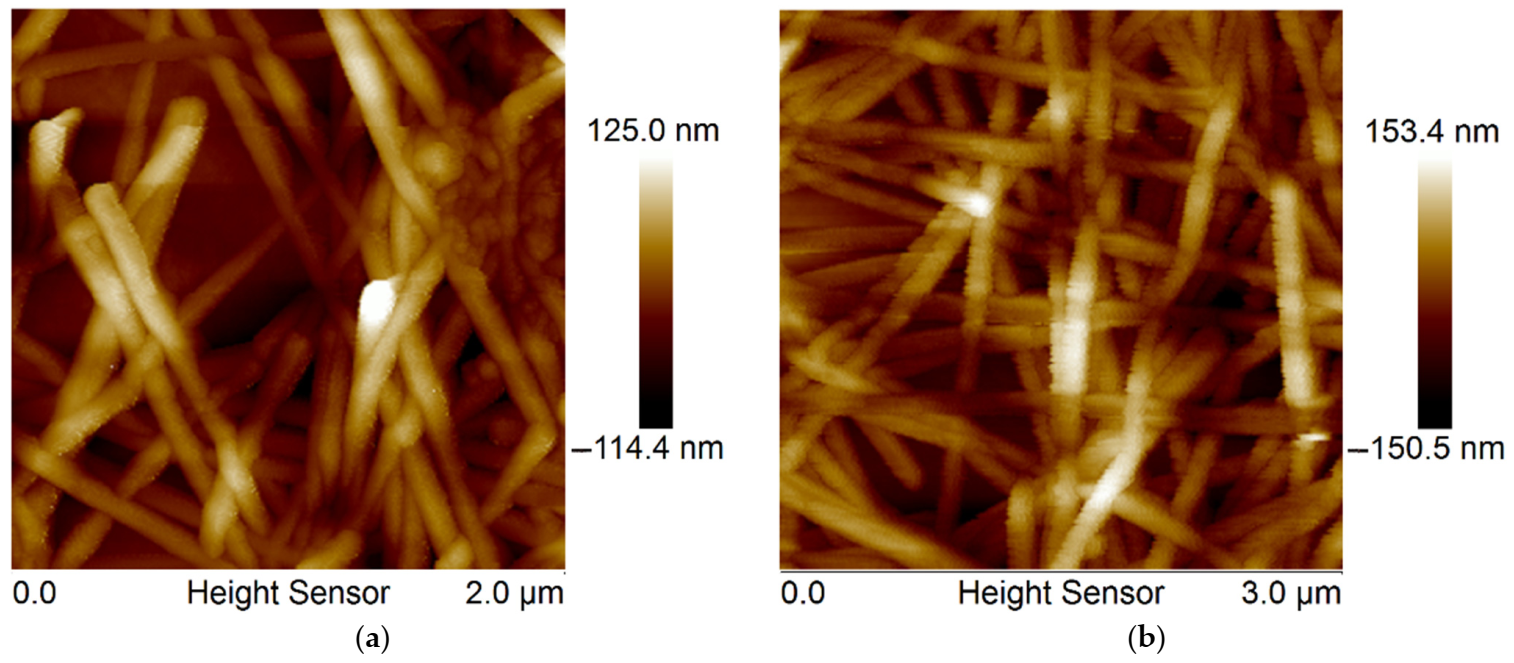
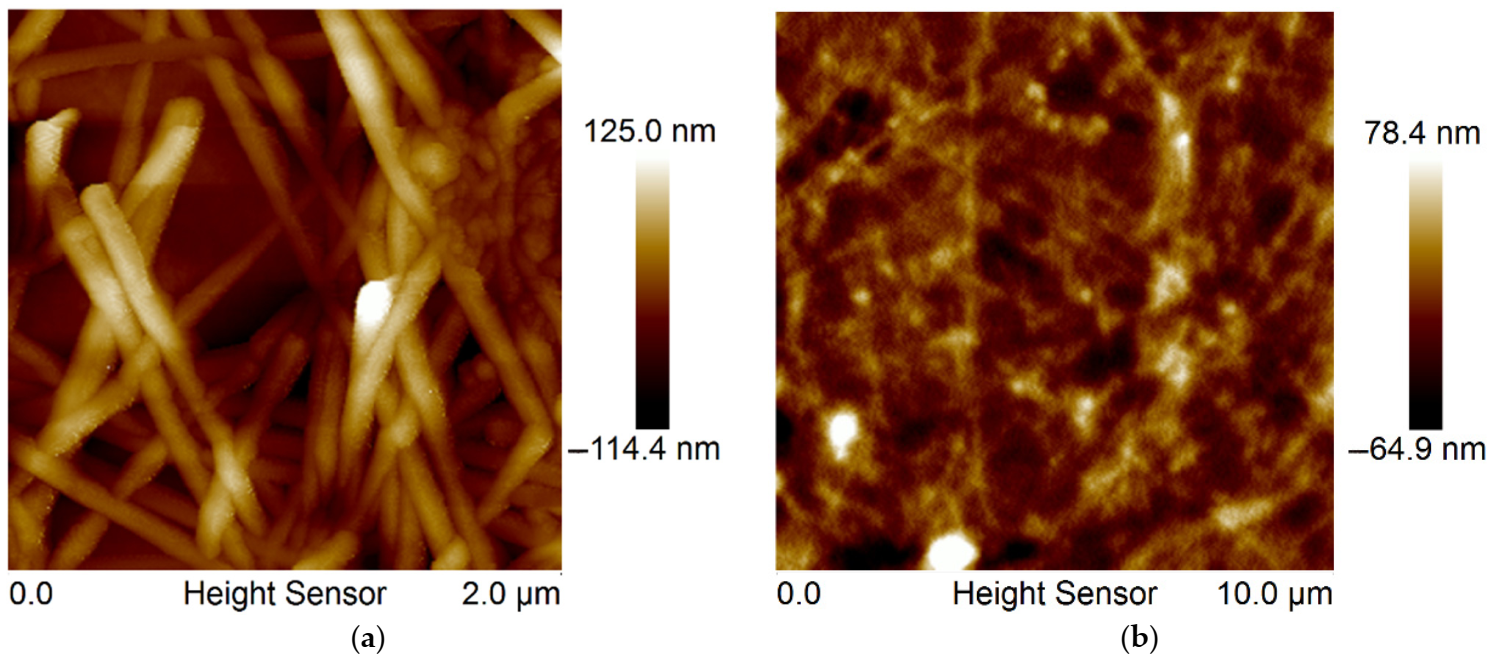

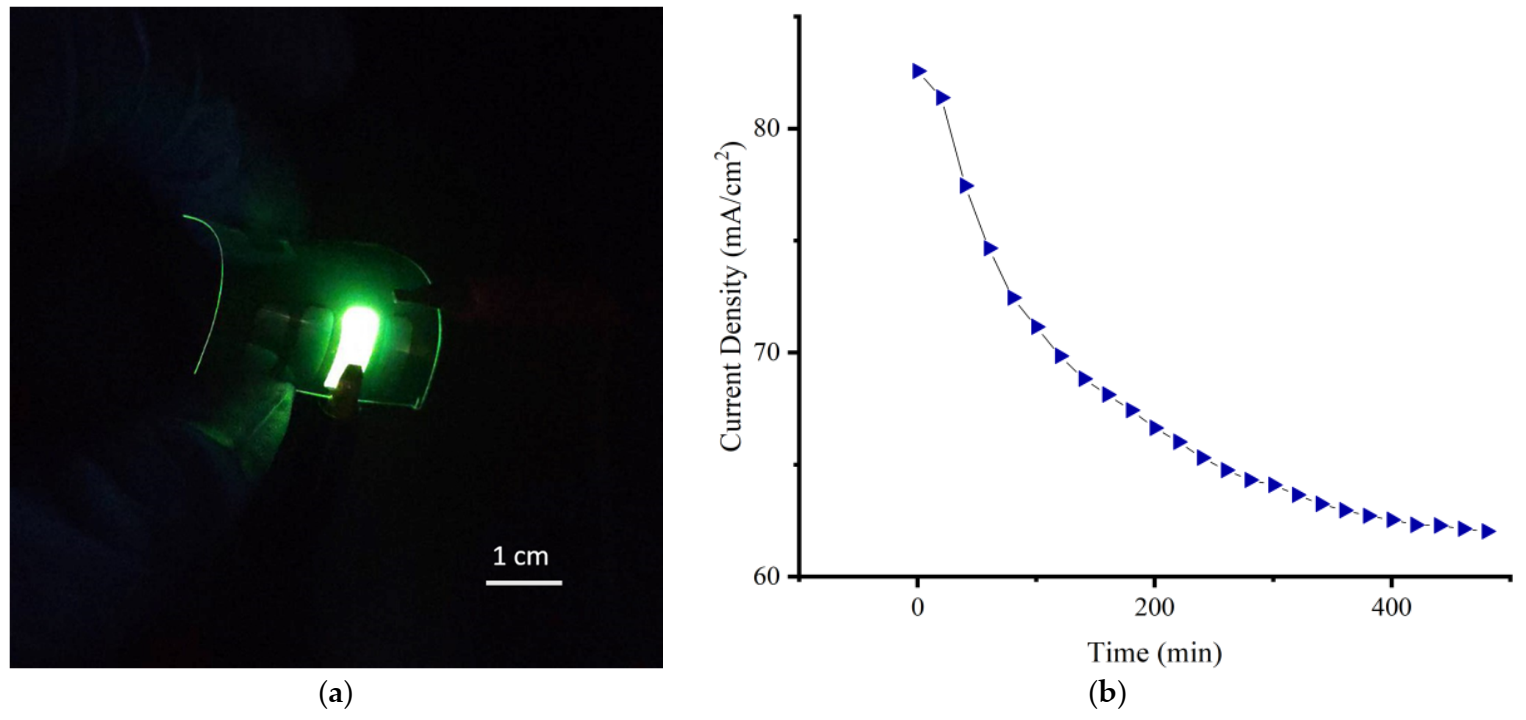

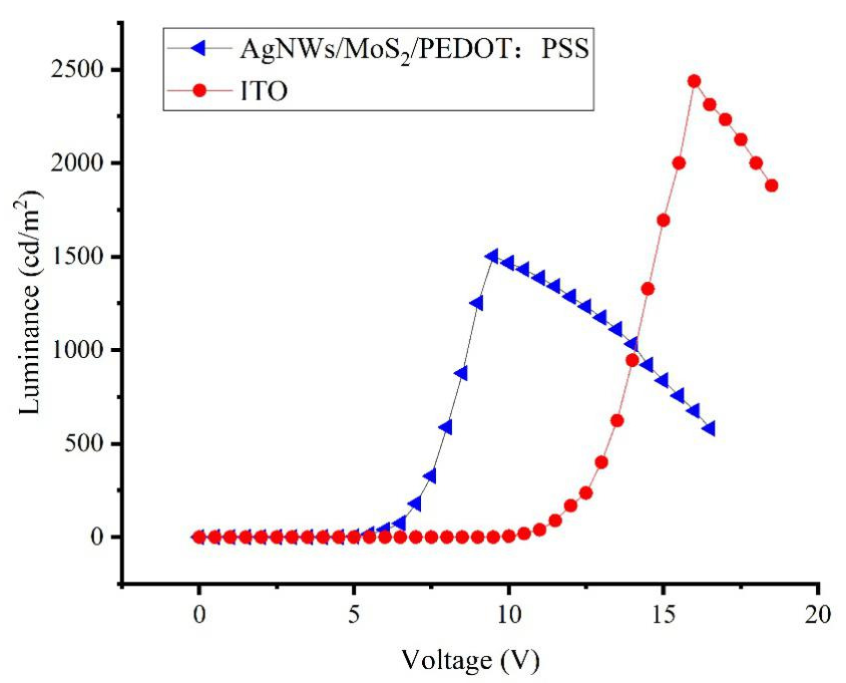
Publisher’s Note: MDPI stays neutral with regard to jurisdictional claims in published maps and institutional affiliations. |
© 2021 by the authors. Licensee MDPI, Basel, Switzerland. This article is an open access article distributed under the terms and conditions of the Creative Commons Attribution (CC BY) license (https://creativecommons.org/licenses/by/4.0/).
Share and Cite
Xu, H.; Liu, P.; Huang, B.; Jiang, X.; Gao, Q.; Liu, L. Preparation of Double-Layer Crossed Silver Nanowire Film and Its Application to OLED. Coatings 2022, 12, 26. https://doi.org/10.3390/coatings12010026
Xu H, Liu P, Huang B, Jiang X, Gao Q, Liu L. Preparation of Double-Layer Crossed Silver Nanowire Film and Its Application to OLED. Coatings. 2022; 12(1):26. https://doi.org/10.3390/coatings12010026
Chicago/Turabian StyleXu, Hengrui, Ping Liu, Bing Huang, Xingwang Jiang, Qingguo Gao, and Liming Liu. 2022. "Preparation of Double-Layer Crossed Silver Nanowire Film and Its Application to OLED" Coatings 12, no. 1: 26. https://doi.org/10.3390/coatings12010026





